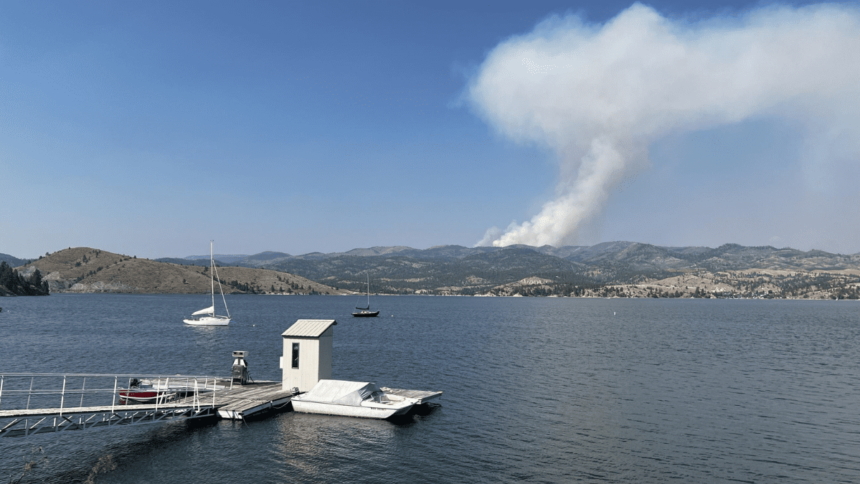A smoky sky set the scene for Gov. Greg Gianforte’s fire briefing on Tuesday, July 16. Standing on a boat launch beside Canyon Ferry Lake, Gianforte listened to updates on the Horse Gulch Fire from Incident Commander Scott Schuster. The report marked the first day the fire was brought under partial containment.
Credit: Zeke Lloyd / MTFP
Speaking to reporters after Schuster’s remarks, Gianforte mirrored the commander’s confidence.
“We have fire season every summer. We prepare for it all year long,” Gianforte said in response to a reporter’s question. “The state’s ready.”

The Horse Gulch Fire began on Tuesday, July 9, and has been attributed to unspecified human activity. The fire lines ran along Jimtown Road to the west and Canyon Ferry Road to the south. By Friday, July 19, the fire’s 14,814 burned acres remained south of the community of York and west of Hellgate Gulch, and was 40% contained.
Further west, the Miller Peak Fire continued to grow 8 miles southeast of Missoula, with 416 responders tending to the 2,035-acre fire. The blaze posed risks to private residences as well as road, railroad, and powerline infrastructure, according to Inciweb. With the fire 0% contained, emergency response authorities on July 15 issued an evacuation warning for residents north of 14380 Upper Miller Creek Road and south of West Fork Schwartz Creek Road.

Credit: Courtesy InciWeb
Across the state, almost 100 miles southeast of Billings and just 35 miles north of the Wyoming border, the Deadman, McGhee, Four Mile, and Prairie fires burned close together, encompassing a combined 38,958 acres. Despite their proximity, responders say they don’t expect the four fires to merge. As of Friday, July 19, parts of both Big Horn and Rosebud counties remain under evacuation warnings as 358 responders work to keep the flames under control.
According to Travis Booth, a meteorologist with the National Weather Service in Missoula, next week’s weather patterns could change wind, temperature, and precipitation conditions. Montana currently sits underneath a high-pressure ridge — a meteorological phenomenon that produces hot and dry conditions. The ridge is likely to break down during the latter part of next week, which could have a mixed impact on ongoing fires.
“Typically we’d see an increase in winds,” Booth said, adding that the breakdown could also lead to cooler temperatures. “And then we’ll have to keep an eye out for showers and thunderstorms,” Booth said.
“We can’t counteract the weather,” Department of Natural Resources and Conversation Director Amanda Kassar said Tuesday on the shores of Canyon Ferry Lake, emphasizing the importance of good wildland maintenance and proactive fire prevention. “That’s been a really important priority of the governor and I,” Kassar said. “We need to be managing our forests better.”

Credit: Courtesy of Flathead Interagency Hotshots
With months of fire season ahead, upper-level leadership expressed confidence in the state’s overall firefighting approach.
“We have a mandate to do ‘aggressive initial attack,’” Kassar said, referencing a strategy rooted in early and thorough firefighting deployments. “And so as these fires continue to pop up and evolve, we’re going to be responding in that exact manner.”
LATEST STORIES
Tester calls on Biden to end campaign
Montana U.S. Sen. Jon Tester is asking President Joe Biden not to seek re-election, saying it has become clear that Biden should end his campaign.
Helena community rallies in support of Horse Gulch Fire evacuees
The Horse Gulch Fire began a little after 1:30 p.m. on Tuesday, July 9. It spread to Cave Gulch within a day, threatening to cross over into Cavetown, the home of Kim’s Marina. On Thursday, July 11, the Lewis and Clark County Sheriff’s Office ordered residents north of Canyon Ferry Road and west of Magpie Gulch to evacuate. Between the mornings of Thursday, July 11, and Friday, July 12, the fire grew from 1,099 to 7,594 acres. Firefighters wouldn’t begin to contain the fire until Tuesday, July 16. Relief efforts ran parallel to the fire’s advance.
Massive Missoula area subdivision garners initial approval
A standalone community with its own farm and potentially hundreds of homes at the Wye west of Missoula has been initially approved by Missoula County officials.




